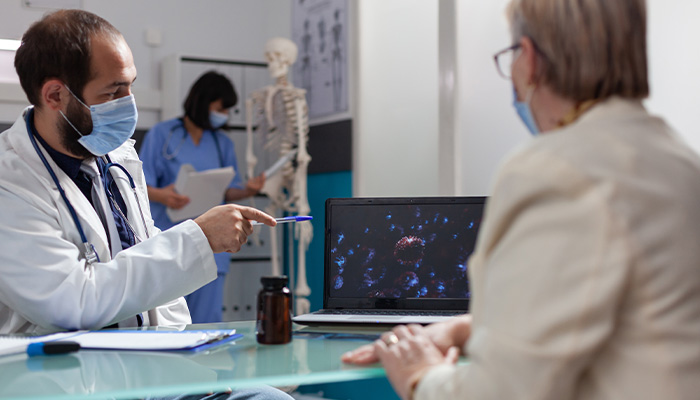How Much Does It Cost to Develop Remote Patient Monitoring Software?

MAY, 17, 2024 15:15 PM
How Much Does It Cost to Develop Remote Patient Monitoring Software?
In recent years, the healthcare industry has witnessed a significant transformation with the advent of remote patient monitoring (RPM) software. This technology allows healthcare providers to monitor patients' vital signs, symptoms, and health data remotely, enhancing patient care, improving outcomes, and reducing hospital readmissions. For businesses and healthcare organizations venturing into RPM software development, understanding the cost factors is crucial. In this comprehensive guide brought to you by PerfectionGeeks Technologies, we'll delve into the intricacies of developing remote patient monitoring software, exploring key components, development stages, cost considerations, and the value it brings to healthcare.
Understanding Remote Patient Monitoring Software
Remote patient monitoring software enables healthcare providers to collect, monitor, and analyze patient data from various medical devices and sensors. It facilitates continuous monitoring of patients' health metrics such as blood pressure, heart rate, glucose levels, oxygen saturation, and more. The software typically includes features like real-time data transmission, alerts for abnormal readings, analytics dashboards, patient portals, and integration with electronic health records (EHR) systems.
Key Features of Remote Patient Monitoring Software
- Device Integration: Integration with medical devices such as wearable sensors, blood glucose meters, blood pressure monitors, ECG machines, and pulse oximeters for data collection.
- Real-Time Monitoring: Continuous monitoring of patient vital signs and health parameters with real-time data transmission to healthcare providers.
- Alerts and Notifications: Automated alerts and notifications for healthcare providers in case of abnormal readings or critical health events.
- Data Analytics: Analytics tools and dashboards for data visualization, trend analysis, predictive insights, and personalized patient care.
- Patient Portals: Secure patient portals or mobile apps for patients to view their health data, receive education, set goals, and communicate with healthcare teams.
- EHR Integration: seamless integration with electronic health record (EHR) systems for centralized patient data management, care coordination, and medical history access.
- Telemedicine Integration: Integration with telemedicine platforms for virtual consultations, remote appointments, video conferencing, and telehealth services.
- Compliance and Security: Compliance with healthcare regulations (e.g., HIPAA), data encryption, secure cloud storage, and patient privacy protection measures.
- Scalability and Customization: Scalable architecture to handle growing patient populations, customizable workflows, and tailored solutions for different medical specialties and use cases.
Development Stages and Cost Breakdown
Developing remote patient monitoring software involves several stages, each contributing to the overall cost of the project:
1. Discovery and Planning Phase
- Market Research and Analysis: Understanding market trends, competitor analysis, user needs, and regulatory requirements. Cost: $5,000$10,000.
- Requirements Gathering: defining project scope, features, functionalities, technical specifications, and user personas. Cost: $8,000$15,000.
- Project Planning: Creating a detailed project plan, milestones, timelines, resource allocation, and budget estimation. Cost: $5,000$8,000.
Estimated Cost for Discovery and Planning Phase: $18,000-$33,000
2. UI/UX Design Phase
- Wireframing and Prototyping: Creating wireframes, user flows, and interactive prototypes for the software interface. Cost: $10,000-$15,000.
- UI Design: designing intuitive, user-friendly interfaces for desktop and mobile platforms, ensuring accessibility and usability. Cost: $15,000-$25,000.
- UX Testing and Optimization: Conducting usability testing, user feedback sessions, and optimizing the user experience. Cost: $5,000$10,000.
Estimated Cost for the UI/UX Design Phase: $30,000$50,000
3. Frontend and Backend Development Phase
- Frontend Development: Developing frontend components, user interfaces, and navigation flows for desktop and mobile platforms. Cost: $40,000$70,000.
- Backend Development: Building scalable backend infrastructure, APIs, databases, and server-side logic for data processing, storage, and communication. Cost: $50,000-$90,000.
Estimated Cost for Frontend and Backend Development Phase: $90,000$160,000
4. Integration and Testing Phase
- Device Integration: Integrating medical devices, sensors, wearables, and IoT devices for data collection. Cost: $15,000-$25,000.
- EHR and Telemedicine Integration: Integrating with electronic health record (EHR) systems and telemedicine platforms. Cost: $20,000-$30,000.
- Testing and Quality Assurance: Conducting functional testing, integration testing, performance testing, and security testing. Cost: $25,000-$40,000.
Estimated Cost for Integration and Testing Phase: $60,000$95,000
5. Deployment and Launch Phase
- Deployment to Cloud Infrastructure: Deploying the software to secure cloud servers for scalability, reliability, and accessibility. Cost: $5,000$10,000.
- Launch preparation: marketing materials, app descriptions, promotional strategies, and app store submissions. Cost: $10,000$20,000.
Estimated Cost for Deployment and Launch Phase: $15,000$30,000
6. Ongoing Maintenance and Support
- Bug Fixes and Updates: Budgeting for ongoing bug fixes, software updates, feature enhancements, and technical support. Cost: 2025% of the total development cost annually.
Estimated Ongoing Maintenance Cost: Variable (2025% of total development cost annually)
Additional cost considerations
- Regulatory Compliance: Costs associated with ensuring compliance with healthcare regulations such as HIPAA, GDPR, and other regional standards.
- Data Security: Implementing robust data encryption, access controls, and security measures to protect patient data.
- Training and Support: training healthcare providers, staff, and patients on using the software effectively.
- Customizations and Add-Ons: Costs for customizing the software based on specific healthcare workflows, specialties, or additional features.
Market Opportunities and Impact of Remote Patient Monitoring Software
The development of remote patient monitoring (RPM) software presents significant opportunities and transformative potential within the healthcare industry.
- Improving Patient Care: RPM software enables continuous monitoring of patients' health metrics, allowing healthcare providers to detect early warning signs, intervene promptly, and provide personalized care plans.
- Reducing Hospital Readmissions: By monitoring patients remotely and detecting changes in health status, RPM software helps prevent complications, reduce hospital readmissions, and optimize healthcare resource utilization.
- Enhancing Chronic Disease Management: RPM solutions are particularly beneficial for managing chronic conditions such as diabetes, hypertension, heart disease, and respiratory disorders, enabling proactive management and patient empowerment.
- Enabling Telemedicine and Remote Consultations: Integration with telemedicine platforms allows for virtual consultations, remote appointments, and telehealth services, improving access to healthcare services and reducing geographical barriers.
- Empowering Patients: RPM software empowers patients to take an active role in their health management, monitor their progress, receive education, set health goals, and engage in proactive healthcare behaviors.
- Data-Driven Insights: The data collected through RPM software provides valuable insights for population health management, clinical decision support, treatment efficacy analysis, and healthcare analytics.
Factors Influencing Cost Variations in RPM Software Development

Several factors can influence the cost variations in developing remote patient monitoring software:
- Project Scope and Complexity: The complexity of features, integrations, customizations, and scalability requirements can impact development costs.
- Technology Stack: The choice of technologies, development platforms, frameworks, and third-party APIs can affect development costs.
- Regulatory Compliance: Ensuring compliance with healthcare regulations, data privacy laws, security standards, and industry certifications requires additional resources and costs.
- Integration with Medical Devices: Integrating with a wide range of medical devices, sensors, wearables, and IoT technologies for data collection and transmission adds complexity and costs.
- User Interface and Experience: Designing intuitive, user-friendly interfaces, mobile apps, patient portals, and clinician dashboards requires UI/UX expertise and may impact development costs.
- Data Security and Privacy: Implementing robust data encryption, access controls, HIPAA compliance measures, and cybersecurity protocols adds to development costs.
- Testing and Quality Assurance: Comprehensive testing, validation, regulatory audits, and quality assurance processes contribute to development costs.
- Deployment and Maintenance: Costs for deploying the software to cloud infrastructure, app stores, ongoing maintenance, updates, bug fixes, and technical support are ongoing considerations.
Cost Optimization Strategies for RPM Software Development
To optimize costs without compromising on quality, functionality, or security in RPM software development, consider the following strategies:
- Minimum Viable Product (MVP): Start with an MVP version of the software with essential features to validate the concept, gather user feedback, and iterate based on market response.
- Agile Development Methodology: Adopt an agile development approach to prioritize features, iterate quickly, and make incremental improvements based on user needs and feedback.
- Open-Source Technologies: Utilize open-source frameworks, libraries, and tools for development, reducing licensing costs and leveraging community support.
- Cloud Infrastructure: Leverage cloud hosting services for scalable, cost-effective infrastructure management, data storage, and server resources.
- Offshore Development: Consider partnering with offshore development teams or outsourcing companies with expertise in healthcare software development to access skilled resources at competitive rates.
- Compliance as a Service: Explore compliance-as-a-service solutions and platforms that offer pre-built compliance frameworks, templates, and tools to streamline regulatory compliance efforts.
- Continuous Monitoring and Optimization: Monitor software performance, user analytics, feedback, and security metrics post-launch to identify areas for optimization, cost savings, and feature enhancements.
Conclusion: Investing in Transformative Healthcare Solutions
In conclusion, developing remote patient monitoring software requires strategic planning, healthcare domain expertise, technology innovation, and regulatory compliance to deliver transformative solutions that improve patient outcomes, enhance healthcare delivery, and drive cost efficiencies. PerfectionGeeks Technologies stands ready to partner with businesses and healthcare organizations in developing and deploying scalable, secure, and user-centric RPM solutions that address evolving healthcare challenges, empower patients, and enable proactive, data-driven healthcare management. By investing wisely, leveraging technological advancements, and prioritizing patient-centric care, businesses can lead the way in transforming healthcare delivery and creating positive impacts on patient health and well-being.
FAQS
What is remote patient monitoring software, and how does it benefit healthcare providers and patients?
Remote patient monitoring (RPM) software enables healthcare providers to remotely monitor patients' vital signs, health metrics, and symptoms using medical devices and digital technologies. This software benefits healthcare providers by allowing proactive monitoring, early intervention, personalized care plans, and reduced hospital readmissions. For patients, RPM software promotes convenience, accessibility to healthcare services, improved health outcomes, and greater empowerment in managing their health.
What are the key features and functionalities typically included in remote patient monitoring software?
Remote patient monitoring software typically includes features such as device integration for data collection from medical devices, real-time monitoring of vital signs, alerts and notifications for abnormal readings, data analytics dashboards for trend analysis and insights, patient portals or mobile apps for patient engagement, integration with electronic health records (EHR) systems, telemedicine capabilities for virtual consultations, and robust security measures for data protection and compliance.
What are the regulatory and compliance considerations when developing remote patient monitoring software?
Developing remote patient monitoring software involves adhering to healthcare regulations such as the Health Insurance Portability and Accountability Act (HIPAA) in the United States, the General Data Protection Regulation (GDPR) in Europe, and other regional standards for data privacy, security, and patient confidentiality. Compliance efforts include implementing data encryption, access controls, secure cloud storage, HIPAA compliant practices, and ensuring patient consent and privacy protections.
How does the cost of developing remote patient monitoring software vary based on project requirements and complexities?
The cost of developing remote patient monitoring software can vary based on factors such as project scope, features and functionalities, technology stack, regulatory compliance requirements, integration with medical devices, UI/UX design complexity, testing and quality assurance needs, deployment infrastructure, ongoing maintenance, and support. A comprehensive project plan and budget estimation are essential to accurately assessing development costs.
What are the potential challenges and considerations in developing remote patient monitoring software, and how can they be addressed?
Challenges in developing remote patient monitoring software may include ensuring interoperability with various medical devices and systems, maintaining data accuracy and reliability, addressing cybersecurity threats and data breaches, navigating complex regulatory landscapes, integrating with existing healthcare workflows, ensuring user adoption and engagement, and providing adequate training and support. These challenges can be addressed through thorough planning, collaboration with healthcare stakeholders, leveraging industry best practices, implementing robust security measures, conducting comprehensive testing, and prioritizing user experience and satisfaction.




Strategy
Design
Blockchain Solution
Development
Contact US!
USA 
1968 S. Coast Hwy, Laguna Beach, CA 92651, United States
Copyright © 2025 PerfectionGeeks Technologies | All Rights Reserved | Policy

